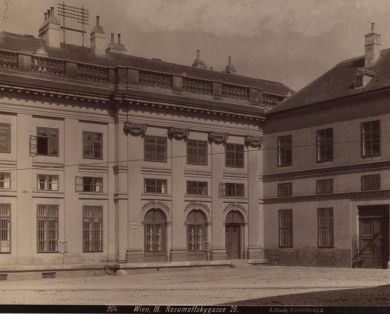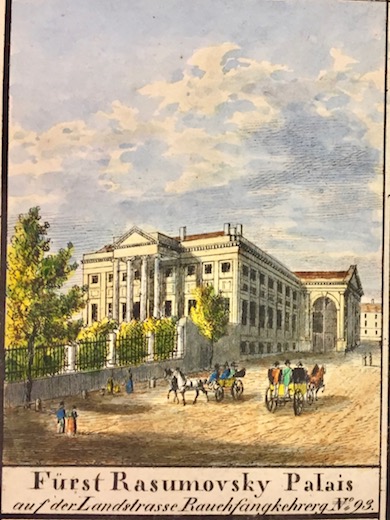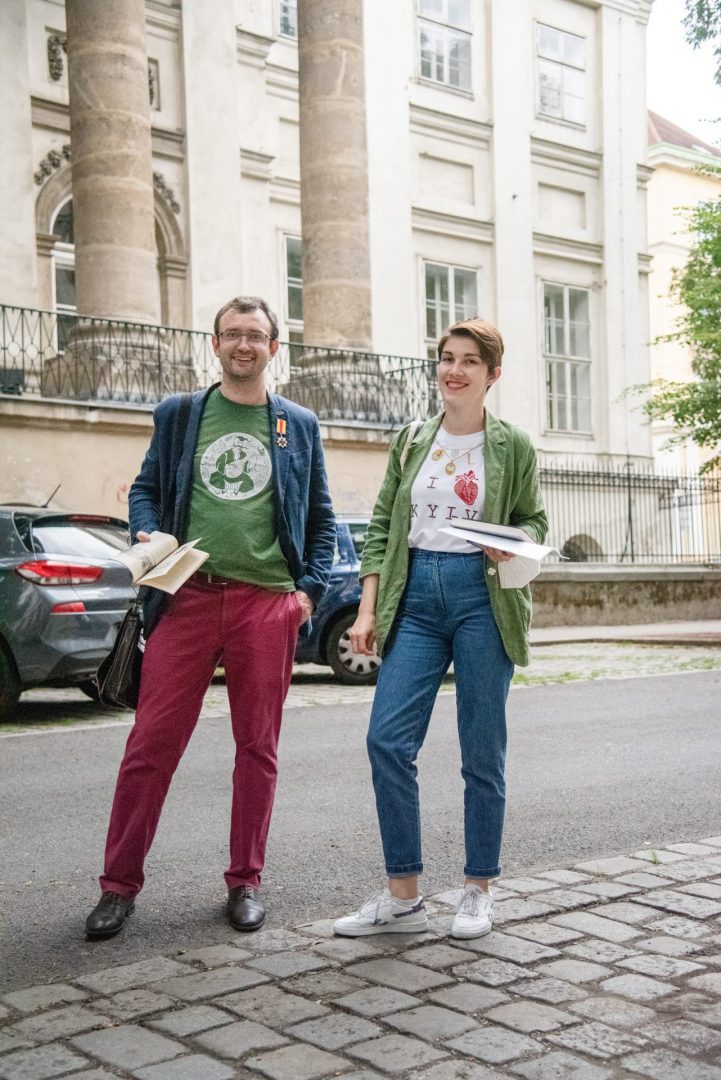The palace with an English garden was built in 1806 by the Belgian architect Louis Montoye. The building was commissioned by Hetmanich Andriy Kyrylovych Razumovsky, the third son of the last Hetman of Ukraine.
He was the only son, who was born in Ukraine – in the city of Hlukhiv, Slobozhanshchyna. During the difficult times of the Napoleonic Wars, he was the ambassador of the Russian Empire in Vienna.
The promo video of the project Interactive Ukrainian Vienna with the images of Palais Rasumofsky views auf TUMA

Rasumofskygasse 25, 1902 © August Stauda // Wien Museum

Palais Rasumofsky © Josef Lex // Flickr
Kyrylo Razumovsky and music
Kyrylo was distinguished by his strong interest in the Age of the Enlightenment and music, he used to play the turban. During his time in Vienna, there was a band of musicians from his hometown, who played Cossack, folk and church songs in Ukrainian. Ivan Olszavsky – the priest of the Greek Catholic Church of St. Barbara in Vienna was so fascinated by the band that he invited them to sing the thanksgiving church service in the Byzantine Rite. At that time, such church services were also held in the Greek Catholic Pochayiv Lavra, Orthodox churches of the ancient Kyiv metropolitanate and Cossack settlements of Taman.

Palais Rasumofsky, 1830 © Carl Vasquez
Ludwig van Beethoven – fifth, sixth symphonies and “Razumovsky Quartet”
Another person who was interested in Ukrainian singing in Vienna was the composer Ludwig van Beethoven. With the support of the Hetmanych, he had the opportunity to work and to create in Vienna. Here he got acquainted with the work “Їхав Козак за Дунай” (eng. A Cossack was going across the Danube) by Semen Klimovsky – the Cossack of the Kharkiv regiment. After that he wrote a cover of “Die schöne Minke”. He also discovered the poltavian song “З-під Києва до Лубен” (eng. From Kyiv to Luben) and many others, on the basis of which he created and dedicated the fifth and sixth symphonies and three bow works “Razumovsky Quartet” to the Hetmanych.
Descendants of Razumovsky in Austria and Ukraine
In his old age, the Hetmanych got deprived of his title. He married the German – Elizabeth, Countess of Thun, and later Constance, Countess von Thurheim. For the transition from Orthodoxy to Catholicism, Hetmanich Razumovsky was partially deprived of his pension. He died with no descendants.

The founders of the IUV project Lidiia Akryshora and Taras Pinyazhko near the Razumovsky Palace in Vienna. August 2021. (c) Yaromyr Babsky
The line of the Ukrainian hetman’s family in Austria was continued by his brother Yurii. They didn’t forget their Ukrainian roots and the testament of Ivan Mazepa, so at the beginning of the First World War, young Razumovsky fought in the ranks of the Austrian Army with the tsarist army on the Galician front, as did the Ukrainian Sich Riflemen.
Just before the First World War, the young great-grandson of Hetman Kyryl, Kamil visited his native region and undertook the reconstruction of the great-grandfather‘s palace in Baturin. His original plan was to put a monument on the site of the family estate in the village of Lemesh, but after changing his mind he built a school named after his great-great-grandmother Natalka Rozumikha in Chernihiv instead. Just like this, the first example of the Ukrainian national secession by Ivan Yakubovych appeared in the Chernihiv region.
Related people
In the 1930s, the Razumovsky family was supporting the Ukrainian national liberation movement. They were informing the world through releases in the press about the right of Ukrainians to their independence and promoting the independence of Carpathian Ukraine.
Since the beginning of the restoration of Ukraine’s independence in 1991 the family has been often visiting their native Cossack Island, as reported by the local press. One of the descendants, Gregor Razumovsky, provided the Salon Razumovsky on Jacquingasse 57 to conduct a charity concert to raise money for the treatment of injured civilian victims of the Maidan.
While analyzing the history of Ukrainian monuments in Vienna, especially the Ukrainian language press in Lviv in the 1930s, it is worth mentioning that the Razumovsky Palace is depicted as one of the monuments of Ukrainian history. That is why the following signs – a memorial plaque from Gazprom on the façade of the Razumovsky Palace and a Cossack figure on the emblem of Moscow Polytechnic University, are retrieved as another political manipulation by Russia.
References
- Акім Галімов. Фільм “Скарби нації. Україна. Повернення своєї історії — Фільм третій” з Грегором Розумовським, Телеканал 1+1, 19.01.2019.
- Іван Німчук. Церква святої Варвари у Відні // Газета “Діло”, 3.10.1925, №220. – С. 2. в libraria.ua.
- Іван Німчук. Нащадки Розумовських у Відні // Газета “Діло”, 14.09.1926, №203. – С. 2. в libraria.ua.
- Слідами гетьмана Розумовського у Франції, Українська історія – маловідомі сторінки, 20.12.2018.
- Rasumofskypalais — Wien Geschichte Wiki.

